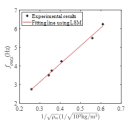Traditional measurements of physical parameters, such as the mass density and the viscosity, require direct contact between the instrument and the sample. However, samples with high activity, radioactivity, and temperature are commonly encountered in certain special cases, especially in the biomedicine and industry of national safety. In that case, it is rather difficult for us to measure the physical parameters through traditional methods in a real container.
The containerless technology prevents the materials from contacting the container wall by virtue of the suspension force field, avoiding the contamination of the vessel wall and the effect of the materials on the container. This method can be used for high temperature measurement and treatment of materials with high purity, activity, radioactivity, and melting point.
In order to solve this problem, researchers from theInstitute of Acoustics of the Chinese Academy of Sciences (IACAS) proposed a new way of inversing the physical parameters based on the dynamics of a sphere levitated in standing acoustic waves. They derived the three-dimensional acoustic radiation force using the acoustic radiation potential function in an arbitrary symmetrical standing wave field, which revealed the correlations between the axial and transverse oscillation frequencies and the wave field as well as the materials. On this basis, they built a laboratory setup for the standing wave levitation and successfully suspend six kinds of spheres, made of aluminum, SiN4, ZrO2, iron, bronze, tungsten steel, respectively.
The results are published online in the international acoustic journal Journal of the Acoustical Society of America.

Fig.1 The laboratory setup for the standing wave levitation (Image by IACAS)
A sphere will experience a restoring force when it deviates from the beam axis. The restoring force is proportional to the off-axial distance in small amplitude approximation, which makes the sphere make a harmonic oscillation in the transverse plane. According to the theoretical result, the transverse oscillation frequency is inversely proportional to the square root of the sphere density. Within the allowable error, the experimental results for these six spheres are basically distributed along a straight line, consisting well with the theoretical prediction. This work is expected to provide a theoretical guide for inversing physical parameters using standing wave acoustic levitation.
Fig.2 The transverse oscillation frequencies versus the mass densities for different solid spheres levitated in air. (Image by IACAS)
This work is partly supported by the National Natural Science Foundation of China (No.81527901), the National Key Research and Development (R and D) Program of China (No.2018YFC0114900), the Goal-oriented Project Deployed by Institute of Acoustics, Chinese Academy of Sciences (No.MBDX202113), and the Youth Innovation Promotion Association, Chinese Academy of Sciences (No.2019024).
Reference:Zang Yuchen, Chang Qin, Wang Xiaozhen, Su Chang, Wu Pengfei, Lin Weijun, Natural oscillation frequencies of a Rayleigh sphere levitated in standing acoustic waves, The Journal of the Acoustical Society of America, 2022, 152(5): 2916-2928. DOI: 10.1016/j.jsv.2021.116261
Contact:
ZHOU Wenjia
Institute of Acoustics, Chinese Academy of Sciences, 100190 Beijing, China
E-mail: media@mail.ioa.ac.cn



